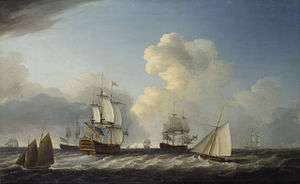HMS St George (1785)
 St George and other vessels. | |
| History | |
|---|---|
| Name: | HMS St George |
| Ordered: | 16 July 1774 |
| Builder: | Portsmouth |
| Laid down: | August 1774 |
| Launched: | 14 October 1785 |
| Honours and awards: |
|
| Fate: | Wrecked, 1811 |
| General characteristics [1] | |
| Class & type: | Duke-class ship of the line |
| Tons burthen: | 1931 (bm) |
| Length: | 177 ft 6 in (54.1 m) (gundeck) |
| Beam: | 50 ft (15.2 m) |
| Depth of hold: | 21 ft 2 in (6.5 m) |
| Propulsion: | Sails |
| Sail plan: | Full rigged ship |
| Complement: | 850 officers and men |
| Armament: | |
HMS St George was a 98-gun second rate ship of the line of the Royal Navy, launched on 14 October 1785 at Portsmouth.[1] In 1793 she captured one of the richest prizes ever. She then participated in the Naval Battle of Hyères Islands in 1795 and took part in the Battle of Copenhagen in 1801. She was wrecked off Jutland in 1811 with the loss of almost all her crew.
Service
In 1793 Captain John Gell was appointed to be a Rear-Admiral of the Blue and raised his flag on the St George.[2] Whilst in the Mediterranean with his division of the fleet, Gell was able to seize a French privateer and its Spanish-registered prize the St Jago. These ships were said to be one of the most valuable prizes ever brought to England.[2] The ownership of the St Jago was a matter of some debate and was not settled until 4 February 1795, when the value of the cargo was put at £935,000 (£86,270,000 in 2016).[3] At this time all the crew, captains, officers and admirals could expect to share in this prize. Admiral Hood's share was £50,000 (£4,610,000 in 2016).[3] The ships that conveyed St Jago to Portsmouth were St George, Egmont, Edgar, Ganges and Phaeton.[4]
In October 1793 Gell was able to obtain the surrender of the French frigate Modeste, which had abused the neutrality of the port of Genoa. After this Gell had to return to England for the last time due to ill health.[2][2]
St George was present at the Naval Battle of Hyères Islands in 1795, and took part in the Battle of Copenhagen in 1801, Flying Nelson's Flag, her captain was Thomas Masterman Hardy, future captain of HMS Victory under Nelson at the Battle of Trafalgar. In 1847 the Admiralty authorized the issuance of the Naval General Service Medal with clasp "Copenhagen 1801" to all remaining survivors of the battle.
Fate
HMS St George was wrecked near Ringkøbing on the west coast of Jutland on 24 December 1811. She narrowly escaped wrecking on a shoal (Rødsand) south of Zeeland on 15 December, while returning from the Baltic Sea. Under jury masts and a temporary rudder she had got a considerable distance out of the Sleeve when a gale came up. This, combined with a heavy sea, resulted in St George being wrecked at Nazen, about three miles from Ringkøbing, together with Defence.[5]
Only seven of her 738 crew were saved.[5] Among the dead were Rear-Admiral Robert Carthew Reynolds and Captain Daniel Oliver Guion.[6] Most of the bodies that came ashore were buried in the sand dunes of Thorsminde, which have been known ever since as "Dead Men's Dunes".[5]
Post script
St George's ship's bell was recovered in 1876 and served as church bell in the church of No near Ringkøbing until May 2011. In May the church renovated its bell tower and consequently presented the bell to the Strandingsmuseum St. George in Thorsminde.[7]
Following the exposure of the wreck of St George by a storm in 1981, thousands of artifacts have been recovered from the wreck, many of which are on display at the Strandingsmuseum St George.
References
- 1 2 Lavery, Ships of the Line vol.1, p179.
- 1 2 3 4 The Literary Panorama, Obituary, 1807
- 1 2 UK CPI inflation numbers based on data available from Gregory Clark (2015), "The Annual RPI and Average Earnings for Britain, 1209 to Present (New Series)" MeasuringWorth.
- ↑ Annual Register, accessed 6 October 2008
- 1 2 3 Gossett (1986), p. 81.
- ↑ Ships of the Old Navy, St George.
- ↑ http://www.lemvig.nu/pages/visnyhed.asp?newsguid=72571
- Gossett, William Patrick (1986). The lost ships of the Royal Navy, 1793-1900. Mansell. ISBN 0-7201-1816-6.
- Lavery, Brian (2003) The Ship of the Line - Volume 1: The development of the battlefleet 1650-1850. Conway Maritime Press. ISBN 0-85177-252-8.
- Michael Phillips. Saint George (98) (1785). Michael Phillips' Ships of the Old Navy. Retrieved 2 September 2008.
External links
Coordinates: 56°21′30″N 8°6′00″E / 56.35833°N 8.10000°E